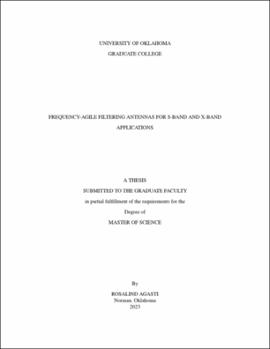| dc.contributor.advisor | Sigmarsson, Hjalti | |
| dc.contributor.advisor | Ruyle, Jessica | |
| dc.contributor.author | Agasti, Rosalind | |
| dc.date.accessioned | 2023-05-16T14:52:03Z | |
| dc.date.available | 2023-05-16T14:52:03Z | |
| dc.date.issued | 2023-05-12 | |
| dc.identifier.uri | https://hdl.handle.net/11244/337698 | |
| dc.description.abstract | Multi-functional, highly flexible, and tightly integrated Radio-Frequency Front-Ends (RFFEs) are at the forefront of the current developments to improve the performance of next-generation wireless RF systems. In the past decade, filtering antennas, or filtennas, have emerged as a potential solution to minimize the Radio-frequency system's cost and complexity while maximizing performance in a highly integrated module. The RF co-design approach of combining the filtering and radiation functionalities into a single unit is beneficial for improving a system's Signal-to-Noise (SNR) performance while limiting interference in a congested frequency spectrum. Furthermore, frequency-agile filtennas can enhance an RF system's adaptation to changing radio environments.
The work presented in this thesis utilizes conventional bandpass filter synthesis techniques to enhance the performance of tunable filtennas for next-generation RFFEs. By using high-$Q$ Evanescent-mode (EVA-mode) cavity resonators and highly efficient slot antennas, multiple filtenna designs are demonstrated. First, the building blocks of the filtennas are individually developed. A novel Evanescent-mode Cavity-Backed Slot Antenna (ECBSA) with contactless capacitive tuning is designed for radiation functionality. Long-range external linear actuators are deployed to tune the critical gap size of the cavity. Experimental results of the antenna demonstrate a high power-handling capacity and wide tuning from 1.7 GHz to 2.6 GHz (40\%). The ECBSA is then integrated with a contactless-tuned EVA-mode resonator to form a 2nd-order tunable filtenna. The fabricated filtenna demonstrates frequency tuning from 2-2.6 GHz (26\%), with a peak realized gain ranging from 2.7~dB to 5.2~dB. The filtenna showed excellent tuning reliability due to the deployed closed-loop monitoring system and exhibits state-of-the-art performance in the class of tunable cavity-based filtennas.
The frequency scalability of the tunable filtenna is next investigated in the X-band (8-12~GHz) frequency regime. A new filtenna structure and tuning scheme is conceptualized by incorporating varactor diodes on a novel superstrate-loaded cavity-backed slot antenna. The performance trade-offs and loss analysis is completed by analyzing the resistive losses associated with tuning varactors. In addition, a new technique is proposed to estimate a varactor's quality factor for high-frequency applications. The proposed method does not require any calibration or de-embedding processes. The varactor-$Q$ estimation technique can effectively estimate the bias and frequency-dependent varactor quality factor for any reconfigurable RF application. | en_US |
| dc.language | en | en_US |
| dc.rights | Attribution-ShareAlike 4.0 International | * |
| dc.rights.uri | https://creativecommons.org/licenses/by-sa/4.0/ | * |
| dc.subject | filtennas | en_US |
| dc.subject | tunable RF and microwave devices | en_US |
| dc.subject | Tuning Varactors | en_US |
| dc.subject | Filtering Antennas | en_US |
| dc.title | Frequency-agile filtering antennas for S-band and X-band applications | en_US |
| dc.contributor.committeeMember | Kerby-Patel, Kiersten C | |
| dc.contributor.committeeMember | McDaniel, Jay | |
| dc.date.manuscript | 2023-04 | |
| dc.thesis.degree | Master of Science | en_US |
| ou.group | Gallogly College of Engineering::School of Electrical and Computer Engineering | en_US |
| shareok.orcid | 0009-0002-9112-8511 | en_US |

